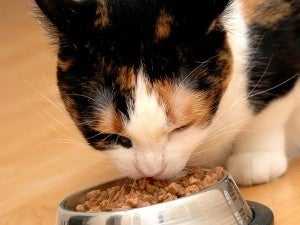Calories in Wet Cat Food

Finding Out the Calorie Content
Just as with human food, pet food must display nutritional information on its label. Unfortunately, the calorie count per serving or per package is not part of the data mandated by law. While some manufacturers voluntarily provide this information on their labels, most do not. Sometimes you can see a canned food's calorie content on the product page of the manufacturer's website. If not, inquire with the manufacturer via a customer service email address or toll-free phone number.
Look at the life stage claim
The life stage nutritional adequacy claim on the label does give useful information as to the suitability of wet food for your cat. This is one of the legally required inclusions, and it's the key to determining which foods are nutritionally balanced for your cat. To be considered, any wet food should explicitly state that it meets the American Association of Feed Control Officials, or AAFCO, guidelines for feeding kittens, cats or both.
Your cat's calorie needs
Although a range of factors affect your kitty's exact calorie needs, basic guidelines have been established. For example, as the Animal Medical Center of Chicago shows, a growing kitten weighing 4 pounds generally needs 275 calories per day, which -- perhaps surprisingly -- is about the same as a healthy 10- to 11-pound adult cat needs. That same adult cat, if deemed overweight and put on a diet by her veterinarian, probably only needs around 180 daily calories, though. Talk to your veterinarian about how many calories to feed your pet each day so you know all the relevant individual factors have been taken into consideration.
Wet cat food is less calorie-dense than dry food
With a typical moisture content around 75 percent, canned cat food is far less calorically dense than dry food, which is usually made up of only about 10 percent moisture, according to the FDA. In other words, wet food is more filling with fewer calories. Whether this is a positive or a negative depends on the situation. If your cat is overweight, it's definitely a plus. If your kitty isn't taking in quite as many calories as your veterinarian recommends, the lower caloric density of wet food may represent a drawback.
Other wet food considerations
Aside from the caloric density, wet and dry cat foods have other significant differences. One key advantage to wet food is that it's higher in the animal-based protein and fat your carnivorous companion needs and lower in unnecessary carbohydrates that contribute to excess weight and obesity, asPetMD points out. Also, the higher moisture content helps prevent dehydration and benefits cats with diabetes or kidney or urinary tract problems. In the cons column, canned food is generally more expensive and, once opened, it requires refrigeration and has a short shelf life.
Your cat's body weight
In the U.S., pet kitties are more likely to be overweight and obese than of a healthy weight, PetMD reports. If your cat has extra pounds, she may struggle to be active and she's at increased risk for developing diabetes, arthritis, fatty liver disease and other problems. The lower caloric density and more nutrient-appropriate content of wet food can help. Also, because canned food can't sit out for extended periods like dry food, your cat is less likely to overeat with free choice feeding. Encourage a return to a healthy weight by limiting treats and encouraging active play. Consult your veterinarian for advice and to rule out medical concerns that may contribute to excess weight.